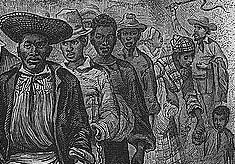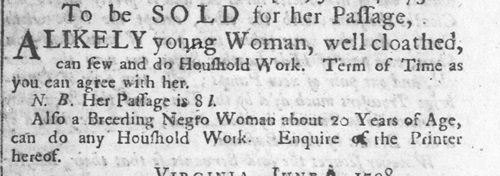
A series of pages exploring various aspects of enslavement in Pennsylvania
Philadelphia Slave Advertisements
June 8, 1738, Two Women, One White, One Black

To be SOLD for her Passage,
A LIKELY young Woman, well cloathed, can sew and do Household Work. Term of Time as you can agree with her.
N.B. Her Passage is 8£.
Also a Breeding Negro Woman about 20 Years of Age, can do any Houshold Work. Enquire of the Printer hereof.
Source: Pennsylvania Gazette, 08 June 1738.
Notes
Colonial America was built in no small part on enslaved labor from Europe and Africa. Immigrants from Europe included the poor, politically or socially persecuted groups, and convicts, while African laborers were enslaved. The cost of shipping enslaved Blacks to the colonies was built into the price for which they sold at market, and their term of service to those purchasing was nearly always "for life." The cost of passage for white laborers was recovered through a period of indentured servitude to the purchaser, typically for seven years.
The advertisement above represents a period when enslaved Blacks were eclipsing indentured Europeans as the preferred form of forced labor in Pennsylvania. This preference is reflected in how each of the women, one white, one Black, is described by the anonymous seller. The first women, a European immigrant, is described as a "likely young woman." The adjective "likely" as used in these ads refers to a pleasing appearance, equivalent to "handsome" for males, and "pretty" for females. She is also "well cloathed," indicating a fine quality, perhaps even stylish, complete apparel, and the particular skill of sewing is noted. By comparison, the Black enslaved woman, who can also do housework, is described similarly to livestock, as a "breeding" woman, 20 years old.
More importantly, the European woman has some bargaining leverage with regard to how long she must serve before becoming totally free. The purchaser must "agree with her" on her length of term. The Black woman has no such power.
For another comparison, see the Comparison of Servant Agreements, from Cumberland County, Pennsylvania.

